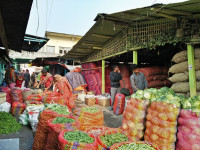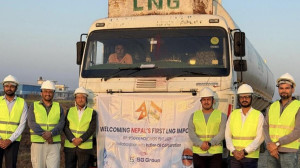Money
Paddy transplantation reaches 40pc in Parsa
Farmers have finished transplanting paddy on 40 percent of the farm lands in Parsa, with the monsoon becoming active and good rainfall being experienced in the district. Paddy is planted on 45,600 hectares in the district.
Shankar Acharya
Farmers have finished transplanting paddy on 40 percent of the farm lands in Parsa, with the monsoon becoming active and good rainfall being experienced in the district. Paddy is planted on 45,600 hectares in the district.
This year, the monsoon entered Nepal on June 12, two days after the normal onset date. However, it was weak and only started to pick up pace last week allowing farmers to transplant paddy.
The District Agriculture Office said that following adequate rainfall and rising water levels in the Gandak irrigation canal, farmers did not delay transplantation.
“As of now, paddy has been transplanted on 40 percent of the cultivable lands,” said Birendra Sinha, chief of the office. “Farmers had sown paddy seedlings on time due to a good pre-monsoon, and this has helped them to speed up transplantation. If the same rainfall pattern continues, paddy plantation will be completed within two weeks,” he said.
Farmers in the southern belt of the district have been able to work faster as water was released from the canal on time, said Damador Yadav, a farmer from Harpatjung.
Likewise, Biruwaguthi, Suvarnapur, Seduwa, Jitpur, Belwa, Madhuban, Bagwana and Haripur in the northern belt also have good irrigation facilities, and this has helped farmers to complete transplantation on time.
Sona Munsuli, Swarna Sub-1 and Sabitri are the popular paddy species grown in the district.
Weathermen have forecast a normal monsoon, bringing hope for another good year for paddy production after recording an all-time high harvest this fiscal year.
The government has targeted to increase paddy output to 5.4 million tonnes in the next fiscal year from this year’s record 5.23 million tonnes.
This fiscal year, the government has implemented the Rs130-billion Prime Minister Agriculture Modernisation Project, which envisages adopting modern farm techniques to boost productivity, and making the country self-reliant in food.
Nepal’s farm sector is expected to register a nine-year high growth rate of 5.32 percent this fiscal year ending mid-July after hitting rock bottom in the last fiscal year, the Economic Survey 2016-17 shows.
The survey said that bumper paddy harvests and a growth in the production of other key food grains helped the sector to make a recovery. Nepal’s farm sector saw a negative growth of 0.19 percent for the first time in the last fiscal year due to summer and winter droughts.
The average rainfall from June 10 to August 15 in the last fiscal year was 74.2 percent of the average rainfall recorded in the past 30 years.
The farm sector is expected to make a contribution of Rs691.2 billion to the country’s gross domestic product (GDP). This is 28.89 percent of the GDP, down from 31.1 percent recorded in the last fiscal.




 19.12°C Kathmandu
19.12°C Kathmandu















